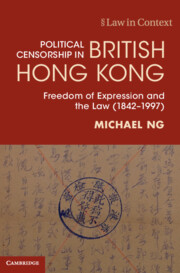Book contents
- Political Censorship in British Hong Kong
- Law in Context
- Political Censorship in British Hong Kong
- Copyright page
- Contents
- Figures
- Tables
- Acknowledgements
- Abbreviations
- Introduction
- 1 Punitive Censorship and Libel Lawsuits against the Press
- 2 ‘Reading Every Line’: Era of the Daily Vetting of Newspaper Proofs
- 3 ‘Communist China Now Contiguous to Hong Kong’: Censorship Imposed by the ‘Free World’
- 4 ‘Patriotism to You Can Be Revolutionary Heresy to Us’: Hardened Control of Media, Schools and Entertainment
- 5 Preparing to Negotiate with China: Overt Loosening and Covert Control
- 6 Liberating Hong Kong for China: De-silencing the City
- Conclusion and Epilogue
- Glossary of Chinese Newspapers
- Bibliography
- Index
5 - Preparing to Negotiate with China: Overt Loosening and Covert Control
Published online by Cambridge University Press: 21 July 2022
- Political Censorship in British Hong Kong
- Law in Context
- Political Censorship in British Hong Kong
- Copyright page
- Contents
- Figures
- Tables
- Acknowledgements
- Abbreviations
- Introduction
- 1 Punitive Censorship and Libel Lawsuits against the Press
- 2 ‘Reading Every Line’: Era of the Daily Vetting of Newspaper Proofs
- 3 ‘Communist China Now Contiguous to Hong Kong’: Censorship Imposed by the ‘Free World’
- 4 ‘Patriotism to You Can Be Revolutionary Heresy to Us’: Hardened Control of Media, Schools and Entertainment
- 5 Preparing to Negotiate with China: Overt Loosening and Covert Control
- 6 Liberating Hong Kong for China: De-silencing the City
- Conclusion and Epilogue
- Glossary of Chinese Newspapers
- Bibliography
- Index
Summary
Chapter 5 reveals how Hong Kong’s freedom of expression was defined and confined by changes in the China strategies of Britain and other world powers. The diplomat Murray MacLehose assumed Hong Kong’s governorship in 1971 with an express mandate from London to build civic pride and raise living standards in Hong Kong to maximise the British bargaining position in negotiations over Hong Kong’s future with a post-Mao regime. In addition to the well-known expansion of social services and efforts to combat crime and corruption, MacLehose’s governorship also featured a hitherto understudied loosening of media control. Yet behind the overt building of a free city were the covert surveillance of political activists and unchanged draconian laws of political censorship that were used to crack down on anti-government dissent whenever it overstepped the government’s political red lines.
Keywords
- Type
- Chapter
- Information
- Political Censorship in British Hong KongFreedom of Expression and the Law (1842–1997), pp. 127 - 163Publisher: Cambridge University PressPrint publication year: 2022

